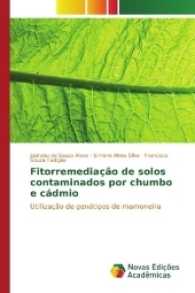Full Description
Separation operations are crucial throughout the process industry with respect to energy consumption, contribution to investments and ability to achieve the desired product with the right specifications.
Our main objective in creating thisgraduate level textbook is to present an overview of the fundamentals underlying the most frequently used industrial separation methods. We focus on their physical principles and the basic computation methods that are required to assess their technical and economical feasibility.
The textbook is organized into three main parts. Separation processes for homogeneous mixtures are treated in the parts on equilibrium based molecular separations and rate-controlled molecular separations. The part on mechanical separation technology presents an overview of the most important techniques for heterogeneous mixture separation. Each chapter provides a condensed overview of the most commonly used equipment types. The textbook is concluded with a final chapter on the main considerations in selecting an appropriate separation process for a separation task.
As the design of separation processes can only be learned by doing, we have included exercises at the end of each chapter. Short answers are given at the end of this book; detailed solutions are given in a separate solution manual.
Contents
From the Contents:
Introduction
- Characteristics of Separation Processes: Significance of Separations - Characteristics - Industrial Separation Methods - Inherent Selectivities - Course Objectives
Equilibrium Based Molecular Separations
- Evaporation and Distillation: Vapor-Liquid Equilibrium - Evaporation - Distillation - Advanced Distillation Techniques
- Absorption and Stripping: Applications - Gas Equilibria - Design Procedures - Industrial Absorbers
- General Design of Gas-Liquid Contactors: Mass transfer in gas-liquid systems - Plate Columns - Packed Columns - Efficiency - Basic Design
- Liquid-Liquid Extraction: Liquid-Liquid Equilibrium - Extraction Schemes - Countercurrent Extractions - Industrial Extractors
Rate Controlled Molecular Separations
- Adsorption and Ion Exchange: Adsorbents - Adsorption Fundamentals - Fixed Bed Adsorption - Basic Adsorption Cycles - Ion Exchange
- Drying: Humidity - Moisture in Solids - Drying Mechanisms - Classification of Drying Operations
- Crystallization: Fundamentals - Crystal Characteristics - Solution Crystallization - Crystallizer Modeling- Other Crystallization Techniques
Mechanical Separation Technology
- Sedimentation & Settling: Mechanisms - Gravity - Centrifugal - Electrostatic - Basic Design - Equipment
- Filtration: Fundamentals - Equipment - Filter Media - Centrifugal - Interceptive
- Membrane Filtration: Membrane Selection - Membrane Filtration - Flux Equations and Selectivity - Concentration Polarization - Modules
Special Topics
- Separation Method Selection: Determining Factors - Feasibility - Liquid Mixtures - Gas Mixtures - Solid-Liquid Systems
Appendix
Answers to Exercises







